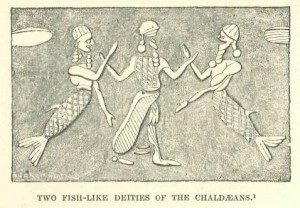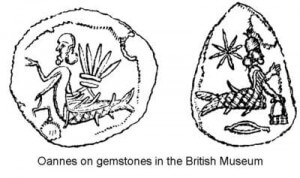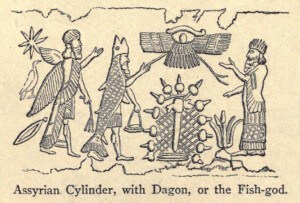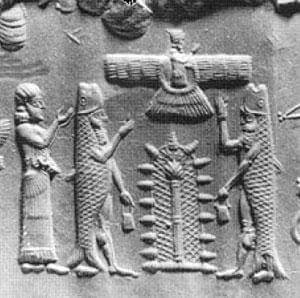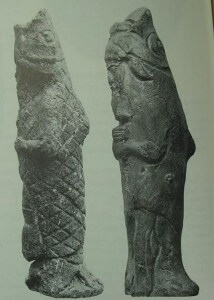
Seven sages, U-Anna Adapa, Óannes
 1
1
 20. 04. 2019
20. 04. 2019

In addition to the names of the oldest legendary rulers, which are known mainly from the so-called "Sumerian royal list", which testifies to an overview of dynasties ruling in various Mesopotamian cities from ancient times, "when the kingdom descended from heaven" to the time of rulers III. The dynasty of Ur and the I. Dynasty of Isin (21st-19th century BC), the mythological-historical tradition has preserved the names of the so-called the sages, which the Sumerians named by name abgal and Babyloňan and Assyrian expression apkallu, which is an obvious borrowing from Sumerian. Unlike the list of rulers, including those rulers of legendary times before flood which originated at the beginning of the 2nd millennium BC, are texts recording wise tradition relatively late. They have been preserved in the form of fragments originating from Nineveh, Ashur and Uruk from the period 1000 BC
Rituals
In most cases, it was the initial incantation and rituals bearing the name Hitter méseri. House of ritual separation (closure) containing reconciliation rituals related to the royal ritual. This introductory incantation addresses the figures of the seven sages, whose paintings (in the form of statues or drawings of men dressed in fish skin with a fish head) played a protective role.
By the names of the seven wise men who belonged pre-flood time, followed by the names of the four sages of the times after the flood and had a relationship with important Mesopotamian cities: Uruku and its rulers Emme (r) kar, Kish, Adaba and Uru with the second ruler of his so-called third Shulgi dynasty (2094-2047 BC)
Text translation:
Wailing: U-Anna, who ordained the order of heaven and earth,
U-Anne-dugga, who had a great deal of wisdom,
Enmedugga, to whom a good fate would be determined,
Enmegalamma, who was born in the house,
Enmebulugga, who grew up,
An-Enlilda, the cleansing priest (city) of Erida,
Utu'abzu, who stepped out of the sky
Seven of them, great fish, sea fish,
The seven wise men, already created in the river, are already guarding the order of the heavens and the earth.
Nungalpiriggaldim, the sage (king) Enme (r) kara, the goddess Ishtar
from heaven to Eanna he descended.
Piriggalnungal, who was born in Kish and who god Adada
he was so angry in heaven
that for three years in the country deprived of rain and greenery.
Piriggalabzu, who was born in Adab and who sealed his seal
he hangs up his neck
and the god Eu was so angry with Apel that the great-uncle killed him with a seal,
which he had on his neck (hanging)
The fourth is Lu-Nanna, (only) two thirds of the sage,
from the (temple) Eninkiagnunna,
the temple of the goddess Istra (king) Sulgi, the great dragon drove.
Together, the four sages of the human race that Ea, Lord,
he gave great reason.
This text is a testimony to an ancient tradition, whose roots still lie in the Sumerian period of Mesopotamian history. Traditions not only of the seven sages who were considered teachers of mankind, but also traditions of heroes from the times after the flood, who for various as yet unclear reasons came into conflict with the gods themselves, and about whom, with the sole exception of the first "pre-flood" sage named U -Anna knows almost nothing. This text would not be so interesting if there were no other texts that provide additional information and contribute to its placement in a broader cultural and historical context.
Table W 20030,7³
One such text is table W 20030,7³ originating from the late Babylonian Uruk. This tablet was the property of a scribe named Anu-bel-shun, the son of Nidintu-Anu, the Uruk priest of the kalu god Anu and the goddess Antum, and the alleged descendant of the famous Sin-leqe-unni, author of the Babylonian version of the Gilgamesh epic. This table contains a list of sages (abgall) and scholars (ummann) who worked in the courts of various rulers from pre-Flood times to the reign of the Assyrian king Asarhaddon (680-669 BC). which derived its origin from the mythical sages of pre-Flood times and, in addition to the already mentioned Sín-leqe-unníni, claimed the heritage of famous scribes such as Kabti-ilí-Marduk, the author of the myth of Err.
From this table, the scientists were most interested in the first eleven lines where they say:
(In time) King Ajjalu was the sage U-an (on),
(in time) King Alalgar was the sage U-An (ne) -dugga,
(in time) of King Ammelu'anna was the sage Enmedugga,
(in time) King Ammegalanna was the sage of Enmegalamma,
(in time) King Dumuzi, the shepherd, was the sage Enmebulugga,
(in time) of King Enmeduranki was the sage Utu'abzu-
(After the Flood), during the reign of King Enme (r) Kara, was the sage Nungalpiriggal,
(who had the goddess Ishtar) descended from heaven to Eanna and a bronze harp,
(of which ……) of lazurite is, with the skill of Ninagala
(made, in ......) ... .. the abode ...... the harp before the god Antem built.
Sumerian royal list
By comparing the initial wedge of the third table Hitter méseri with the Urucki list there is an almost complete agreement between the names of the seven pre-Flood sages, the considerable similarity of the two names of the first sage after the flood, its identical connection with the mythical Uruk ruler Enme (r) karem and a complete agreement in the description of his deed relating to the goddess Ishtar. And the same names, or their variants, are listed at the very beginning of the list of Sumerian rulers, the so-called Sumerian royal list whose surviving manuscripts date from the 19th and 17th centuries. century BC as the names of the seven rulers ruling in the four oldest pre-Flood cities. The cities of Erid, Bat-tibira, Larak, Sippar, Šuruppak are named as centers of royal power before the flood in the best-preserved text (the so-called Weld-Blundell prism).
The translation of the text reads:
When the kingdom came down from heaven, the kingdom was in Erid. In Erid he was king of Aluli, he ruled for 28 years, then Alalgar ruled for 800 years. The two kings ruled for a total of 36 years.
Eridu fell (a) the kingdom was transferred to Bad-tibira. In Bad-Tiber, he ruled Enmenlu'anna for 43 years, (then) ruled Enmengalanna for 200 years,
(after) the reigns of Dumuzi, shepherd, 36 years. The three kings ruled for a total of 000 years.
In Larak, Ensipazi'anna ruled for 28 years. One king ruled for 800 years. Larak fell the kingdom was transferred to Sippar.
Enmendurann ruled Sippar for 21 years. One king ruled for 000 years.
Sippar fell (a) the kingdom was transferred to Šuruppaku.
Uur-Tutu ruled in Shuruppak for 18 years. One king ruled for 600 years.
Eight kings ruled in five cities for 241 years.
Then, when the flood was over, the kingdom came down from heaven, and the kingdom was in Kish.
The first Greek writer of Babylonia
The poetry of the names of the legendary Sumerian "pre-flood" rulers and mythical "sages," the first teachers of mankind to celebrate the ascension of the human race, is also recorded in the fragments of the first book of the Greek Babylonian, the author of which was a Babylonian scholar named Berosos. This Chaldean priest of the Babylonian temple of Esagil, god Béla-Marduka, was probably born around 340 b. and as a learned astrologer he worked in the yard of the Seleucus rulers of Mesopotamia. It can be assumed that, when writing his work, Beróssos leaned on the springs of the Sumerian rather than the Arkadian springs.
The famous Greek writer of Syrian origin Lúkiános of Samomata, Alexander Polyhistor, Ioseph Flavius, Abydén, Eusebius of Kaisareia and others certainly became acquainted with Béróss's presentation, either directly or indirectly. Beróss's work of Babylon consists of three volumes. The first volume deals with the very beginnings of human culture, the creation of the world and man, it contains some astronomical and astrological passages, the authenticity of which, however, is questioned. The second book mentions ten pre-Flood rulers, describes the flood, calculates eighty-six ancient rulers after the flood, and records historical dynasties up to the Babylonian king Nabonassar (Nabú-námir, 747-734 BC). domination.
The opening part of the book
I would like to talk about the introductory part of the first book, which tells of the beginnings of the human race, the wise monsters, the teachers of humanity who have familiarized them with the foundations of civilization, and the first rulers until the time of the great flood.
Many different nations lived in Babylon and settled in Chaldea. They lived without laws like beasts. However, in the first year, the monster "Óannés" (U-An (na)) emerged from the Red Sea (Persian Gulf) in places adjacent to Babylon. His whole body was fishy, at the top under the fish's head he had grown a human, his legs were human and grew out of a fish's tail. The monster's voice was also human. Its appearance is preserved to this day. The monster stayed among the humans all day without eating any food. He taught people science and art and various crafts, taught how to establish cities and temples, how to establish laws and boundaries of land; he also showed them how to sow and how to harvest the crop and everything one needs for daily life. Nothing important has been discovered since then. After sunset, Óannés dived back into the sea and spent the night in the ocean; it was an amphibian.
Further on mythical "pre-flood" kings, he writes this:
The first king was Chaldea Alóros (Alulim) of Babylon, ruled by 10 sars… He was ruled by Alaparos (Alalgar) and Amélón (Enme (n) lu'anna), both from Pautibiblioi (Bad-tibira). Alaparos ruled 3 sars, Amélon 13 sars. After this, Chaldean Ammenon (Enmenunna) ruled for 12 sars. During his reign, the monster Annédótos (U-An (ne) - dugga) Óannés emerged from the Red Sea, in the form of man and fish. He then ruled 18 sar (A) megaloros (Enme (n) galanda) from the towns of Pautibiblioi, followed by the shepherd Daónos (Dumuzi) from the same town ruled by 10 sar. During his reign, four monsters appeared, which had the same form as before, namely a mixture of human and fish. Their names were: Euedókos (Enmedugga), Eneugamos (Enmegalamma), Eneuboulos (Enmebulugga), Anémentos (An-Enlilda).
Then Euedórachgos (Enme (n) duranna) of Pautibiblioi ruled for 18 sars. During his reign, another monster appeared named Anodafos / Odakon (Utu-abzu). Following Óriartés (Ubar-Tutu) from the same city, he ruled 10 sars. Then after the death of Oriart, his son Xisutth (Ziusudra, Utanapishtim, Noah) ruled 8 sars… During his reign broke out great flood.
Béróssos built wise tradition to the very foundations of its submission. Long sages were as important to him as the first antediluvian rulers, he considers them not only to be the teachers of the first people, but also as the creators of the whole civilization structure, for as he himself demonstrates, nothing has been discovered since then.
Klínopisné texty
References to a group of these mythical sages (abgal, apkallu) appear here and there in other cuneiform texts. For example, I will mention the myth of Err, in which the mouths of the god Marduk himself are described as beings who know the secrets of making divine idols who, after performing the appropriate rituals, have become essential to the gods themselves.
The translation is:
I took the masters to Apsu and did not allow them to come out. The place where the flesh tree grows and where the elmesh stone is found, I changed and did not show anyone… Where the flesh tree grows, the body of the gods belonging to the king of the universe, pure wood, a noble bachelor who has talents to rule, rooted by the waters of the open sea miles into the depths of the underworld and the crown of his sea touches the (Antova) sky? Where are the seven wise men of Apse, pure fish, like Ea, their lord, with great wisdom endowed, and who cleanse my flesh.
Mention of them also appears in the epic of Gilgamesh, where they are referred to as the builders of the famous city wall of Uruk:
Exit to the top of the Uruguay wall, walk through it,
explore the foundation, see the brick!
The brick is not burned
and the foundation did not make the sages seven? "
Of the seven sages mentioned above, the name of the first of them, the name U-An (na) Adapa, which occurs in various forms: U-An (na), U-An (na) Adapa, Uma-Anum, most often appears in the cuneiform literature. / Anim Adapa, Adapa. It is an abbreviated form of the Sumerian name.
U-an- (na) -a-da-pa, which perhaps can be translated as "the light that is in heaven," "the light that met An," from which the Greek form of the sage's name Óannés was derived. In one of the Sumerian-Akkadian lexical collections, Adam's expression is equivalent to the Sumerian conjunction U-tu-a-ab-ba "born in the sea" and is referred to as "wisdom" in the context of several other Arkadian adjectives.
The Assyrian rulers Sinacherib (704-681 BC) and Asarhaddon (680-669 BC), Ashurbanipal (668-627 BC) compare their wisdom to the wisdom of Adapa himself. They claimed that they had mastered his skill, his work, his message with a special emphasis on the art of writing. Literally that they can read the ancient script before the flood or even that they are labeled as descendants of Adapa. Thus, Adapa is considered a sage who imparted to mankind the knowledge of the art of writing and himself, at the instigation of the gods, wrote some important texts, is proficient in magic and magical literature, is an expert in the names of God, and is a temple builder.
The Adapian tradition is divided into two branches, one of which connects him with the first "pre-Flood" ruler of the city of Erid named Alulim, Alulu, Ajjalu, Alóros and the other puts him alongside Enmerkar, the legendary builder of the city of Uruk. Adapa's connection with Uruk and his ruler Enmerkar is evidenced by a fragmentary record from one of the Babylonian chronicles.
Enmekir, king of Uruk, destroyed the population, …… the sage Adapa …… heard in his sanctuary clean and Enmekir ……… I gave him dominion over all lands ……… built the heavens beautifully, in the temple of Esagil …… the universe of heaven and earth, the eldest son …… ..
Epic song
In addition, five fragments have been preserved (three from Nineveh, one from Sippar and one from Uruk) with an epic text about Adapo and Enmerkara, whose largely damaged and incomplete text suggests that Adapa and Enmerkar opened a kind of ancient tomb, which eventually Adapa he ordered to close carefully. The most important and undoubtedly the most famous text relating to the character of Adapa is the so-called "Legend of Adapo" or "Adapa and the South Wind". From this text it can be deduced that God Ea / Enki created Adapa as a follow-up model of all men and endowed him with wisdom that perhaps even exceeded the wisdom of some gods.
He merely denied him, as all human beings, eternal life. For some, the legend of Adapo is primarily a celebration of the city of Erid as an ancient Sumerian cult center, for another Adapa is a bearer of obedience and unwavering faith in his master. At first glance, the blindly obedient Adapa in myth seems to be just a pun in the hands of the mighty gods Anu and Ey, but there are other, more subtle and less distinct elements in the text that have been revealed in the long process of his study. Adapa accidentally tasted the power of the spoken word, and God Anu wanted to hide it from the people. Therefore, Adapa was called to the heavens, where he was to dwell forever, and he dreamed of his experience, but if he did not obey the Era Councils. For his obedience, Adapa returned to the earth, enriched with the knowledge that no other mortal had ever received.
It is not yet certain whether a direct connection can be declared between Adapa and one of the figures of the biblical ancestors, or between Utu'abzu, the seventh pre-Flood sage of King Enmeduranki, who ascended to heaven, and Enoch, the seventh ancestor in a row from Adam, who " he walked with God "and" God took him. " The direct contact of some personalities with the divine figure, their transition into the divine realm (ascension to heaven), the "monstrous" form of man and fish of some individuals, suggest that this is probably not a mere coincidence.





